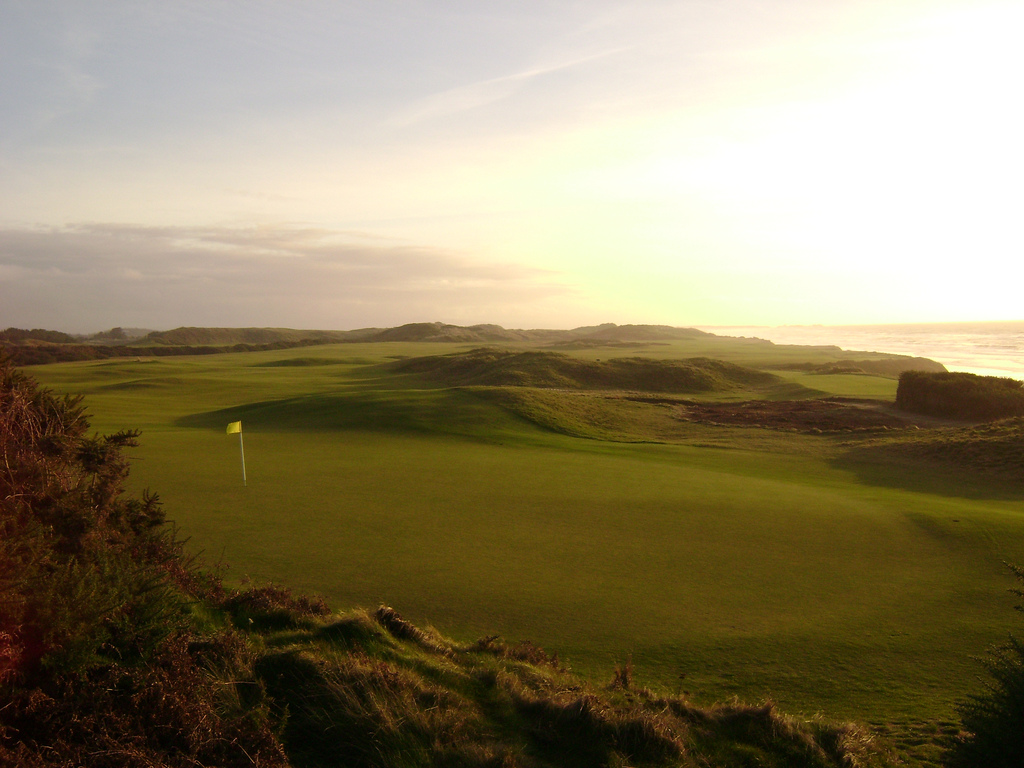If you have ever had the opportunity to play a seaside links course, you will probably recall breathing in the salt infused air, gazing out across the ocean and then back towards the rumpled fescue landscape laid out in front of you.
Your pulse begins to quicken as you recognize the challenge that awaits you over the next eighteen holes. There will be blind tee shots, blind approaches, deep bunkers, fairways nestled between rolling dunes covered in long grass, and very tricky greens.
The course looks like it has been there forever, on land meant for “dream golf”.
Whether you are at Ballybunion in Ireland, Askernish in Scotland, Pacific Dunes in Oregon or Barnbougle Dunes in Tasmania, you know that you are fortunate to be in such a breathtaking setting with a bag full of clubs and some golf balls.

The 12th at Pacific Dunes – Photo by Kyle Henderson
The landscape of these great links courses, and many fine inland courses, are not blighted by the obvious hand of man. There are no artificial lakes or ponds, no fountains or imported trees, and there are certainly no concrete cart paths or fleets of golf carts disturbing the natural perfection of the course.
Many North Americans have never seen a real links course or even an inland course that has been built without cart paths. For every Ballyneal in Colorado, there are hundreds of Stone Eagles in California. Ballyneal and Stone Eagle are both well respected golf courses designed by Tom Doak who is recongized as one of the top golf course architects in the world. The main difference between these two courses, aside from setting, is that one can be walked and the other cannot. I have been told by golfers who have played both, that Ballyneal is a superior golfing experience to Stone Eagle because there is an opportunity to enjoy every step of the round while experiencing the environment that Doak has designed specifically for the walking golfer. Stone Eagle might be an 8, but Ballyneal is a 10.
While riding in a cart, it is impossible for the golfer to experience the subtle undulations of the fairway, the efforts that the architect has put into flowing the course across the land from tee to fairway to green. It is difficult to understand how a fairway bunker or greenside bunker adds value to the hole if you never see it or if you walk past it while running to and from the cart path. Even if carts are allowed on the course, you speed across the land too quickly to understand the nuances of the design, while criss-crossing the fairway searching for each players ball. The noise of the cart, the distraction of focusing on the cart path and the limited visibility of riding in a cart are factors that contribute to an inferior golfing experience versus walking. You see the course from the tee, from wherever you hit your approach and from the green, but the experience inbetween is lost.
Many golf courses in North America are built for “cart golf”, meaning they are target oriented courses that may have impressive vistas and scenic views, but they are severely lacking the subtle nuances that make a great golf course. This is understandable, because the cart golfer will rarely notice slightly rumpled fairways or the way the tee shot will flow into strategically placed fairway bunkers because they are moving too quickly across the land or are driving on paths next to the hole.
It is little surprise that many of the top ranked courses in the America were built before 1950, a time when golf carts did not exist. “Golden Age” architects were focused on providing a complete golfing experience that took advantage of the natural contours of the land. Many modern architects have attempted to “create” an experience by shaping the land to fit their view of what it should look like.
Keys to creating a good walking experience include the following:
– Interesting terrain that exists in a natural environment suitable for golf – ie) not on the side of a mountain
– Land set aside specifically for golf with no routing restrictions – ie) not part of a housing development
– An architect who is interested in working with the natural features of the land
– An architect who is committed to creating relatively short green to tee transfers – ie) ideally no more than 50 yards
– An architect who is committed to creating direct routes for the walking golfer to get from the tee to the fairway and green
– An architect who has the ability to use large elevation changes within hole designs and not between holes
– A developer who is committed to building a course that is suitable for the walking golfer If these key principles are adhered to it is likely that the architect and developer will create a venue that is thoroughly enjoyable for the walking golfer which will maximize the golfing experience, and frankly, minimize construction and maintenance expenses.
By choosing to walk we play, golfers are sending a message to golf course developers and current golf course owners. We are letting them know that golf is an experience to be enjoyed from tee to green and that, to receive our patronage, their course needs to provide a complete experience.
If you currently ride in a cart when you play, it might be worth walking a couple of holes on your next round to understand what I am talking about. Stretch your legs a bit, breath in the air, take in the sights and sounds of the setting and soak up the design of each hole while you are playing. It is likely that you will notice subtleties that you have never seen before, while getting a little added exercise.

What a great message you represent! Next time you are in Bandon, if you are a true fan of “golf as it used to be” please consider a visit across old town Bandon, to Old Bandon Golf Links, currently the only public golf facility in the US to offer the option of renting 1890’s and 1920’s era hickory-shafted clubs with period appropriate balls (we have both authentic gutta percha as well as Jone’s-era wound core balls). The 2,200-yard course was built in 1927, designed for the 150-160 yard drives, with Johnson Creek winding through the center of the course providing scenic charm and challenge on 7-holes. Our clubs and balls are provided by McIntyre-White Authentic Golf whose founders are also members of the Golf Collectors Society.
Thanks and best wishes to you as you host this wonderful concept!